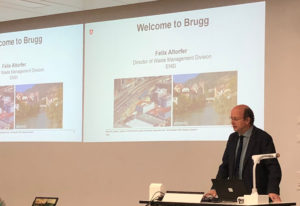Deep geological repositories: 150 experts discuss long-term safety
On 4 and 5 November, ENSI hosts the DECOVALEX 2019 Symposium in Brugg. This research conference welcomes international delegates to discuss the long-term safety of deep geological repositories for radioactive waste.
ENSI joins efforts with the US-based Lawrence Berkeley National Laboratory to host the DECOVALEX 2019 Symposium, an experts’ conference on the long-term safety of deep geological repositories. Over 150 delegatess in the field attend the international research conference in Brugg on 4 and 5 November 2019, which is based on the DECOVALEX research collaboration project that involves regulatory authorities, research institutions and radioactive waste management organisations of many countries. For the first time in the research programme’s nearly 30-year history, the project’s findings are presented in a symposium with an international audience of experts.
DECOVALEX research collaboration
The project was initially set up in 1992 at the instigation of the Swedish regulatory authorities, however, research activities within the project are coordinated by the US-based Lawrence Berkeley National Laboratory. The project is currently supported by funding from ENSI and twelve other organisations.
The DECOVALEX research collaboration project enhances ENSI’s international networking efforts. ENSI experts were among those presenting their research findings from experiments at the Mont Terri underground research laboratory to the audience of experts. Such modelling uses 3-D approaches e.g. to demonstrate the behaviour of underground rock strata when water penetrates faults existing in the rock.
How do rocks change over a thousand years?
Changes in temperature, water pressure, geomechanical behaviour and chemical processes are modelled over time scales of centuries tomillennia under alternating boundary conditions. Scientists working on the DECOVALEX project focus their efforts by developing, improving and applying computer programs to model the processes that take place deep inside the rocks around a deep geological repository. Findings are then compared internationally and also with empirical results.

ENSI’s involvement in the DECOVALEX research programme has a profound impact on ENSI’s role as a supervisor for radioactive waste disposal in deep geological repositories in Switzerland. The models developed in the research project are an important key to assessing the safety of any proposed radioactive waste disposal solutions. Modelling efforts of ENSI focus on thermo-hydro-mechanical processes in Opalinus clay, the intended host rock in Switzerland.
The only safe solution in the long term
The issue of waste disposal is one of ENSI’s main concerns in the context of regulatory safety research. Alongside projects on the transportation and intermediate storage of radioactive waste, research programmes looking into deep geological repositories have become increasingly important in recent years. The Swiss Nuclear Energy Act (NEA) states that all radioactive waste in Switzerland must be disposed of in deep geological repositories, as these are the only safe solution in the long term.

